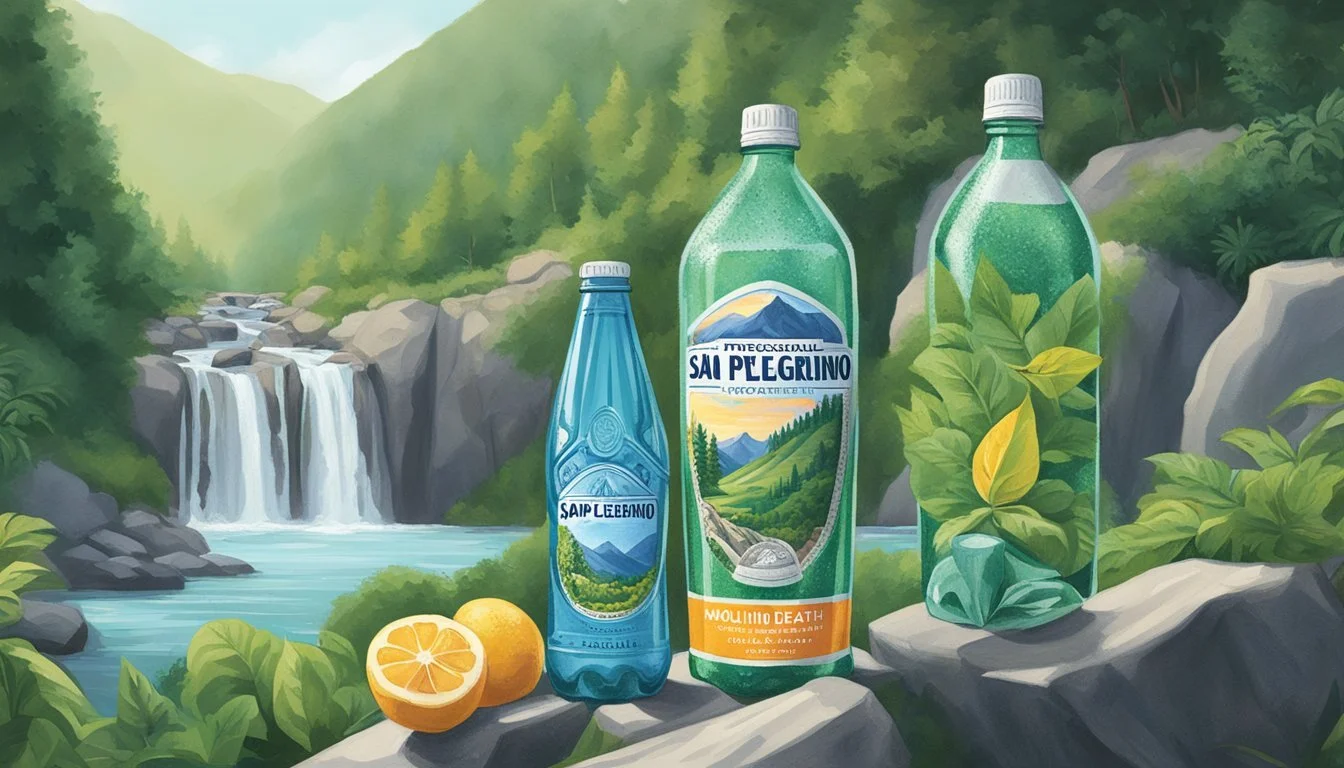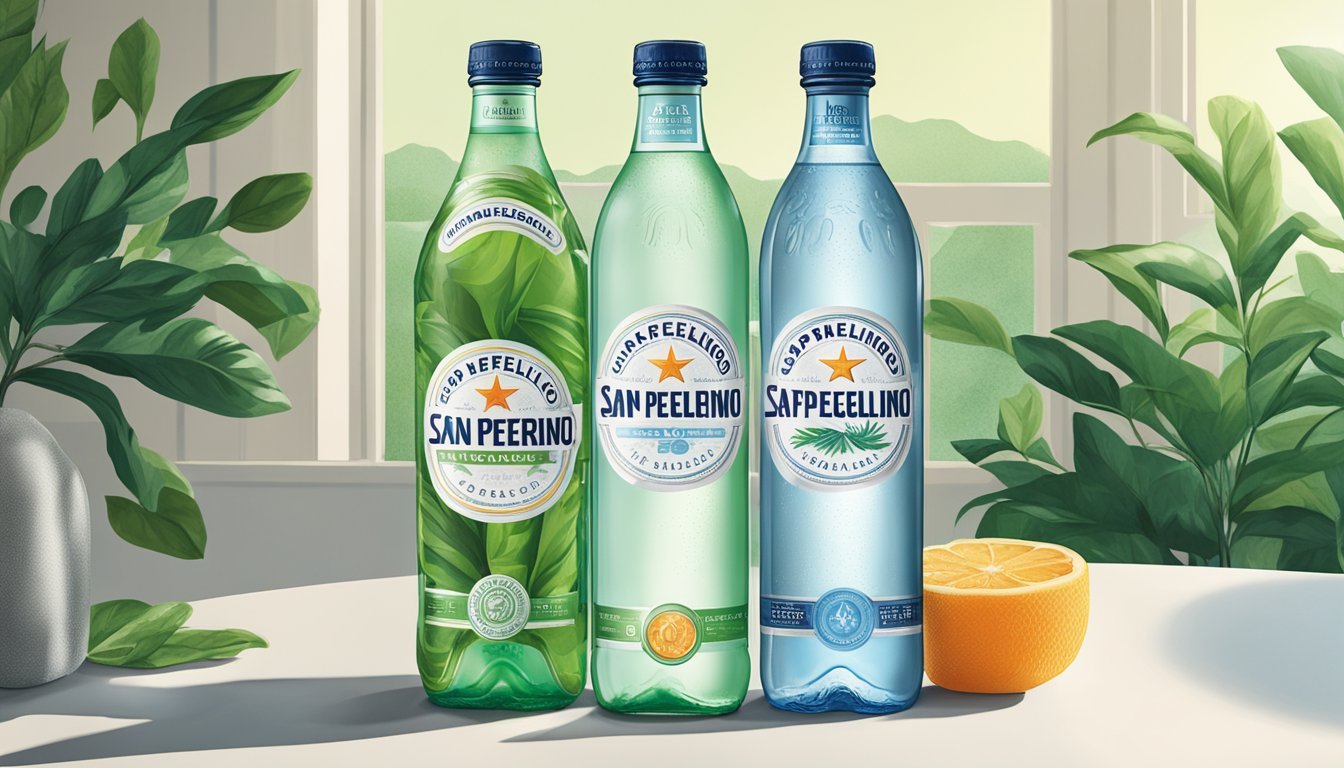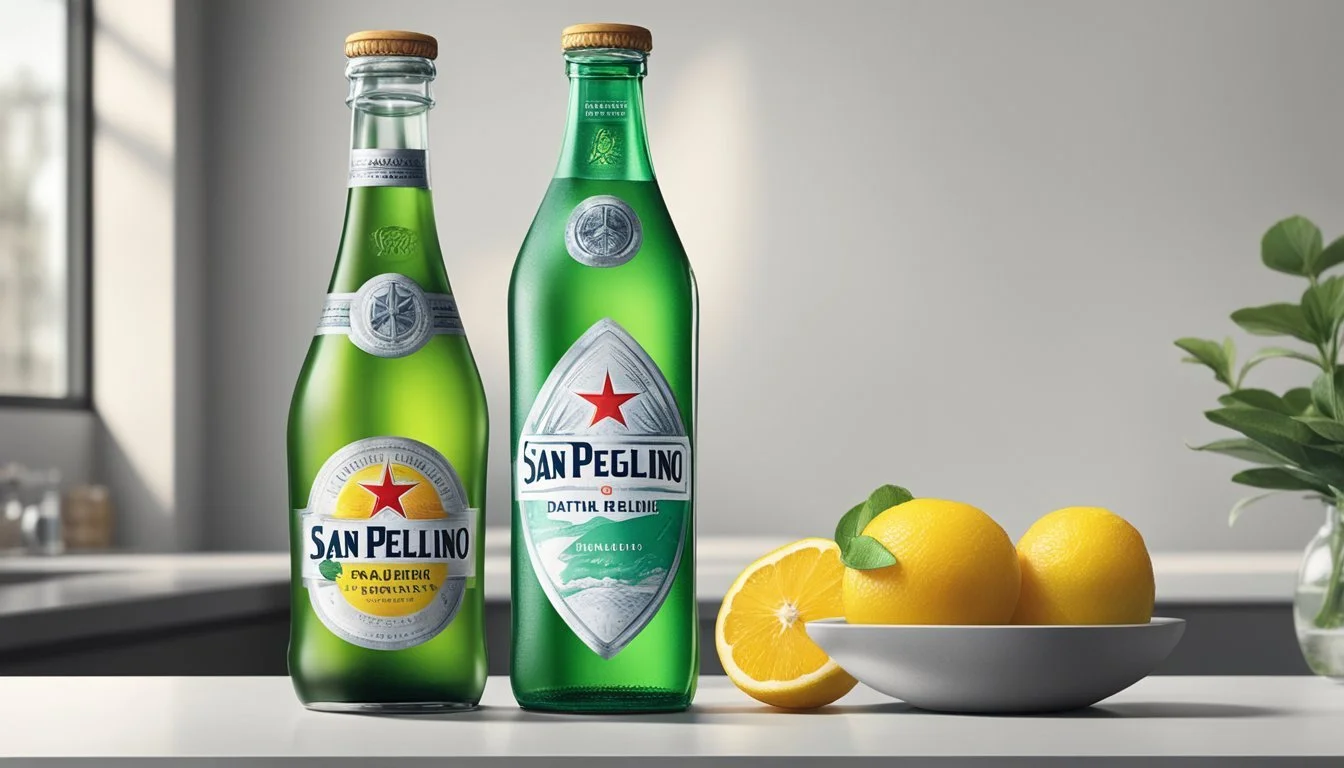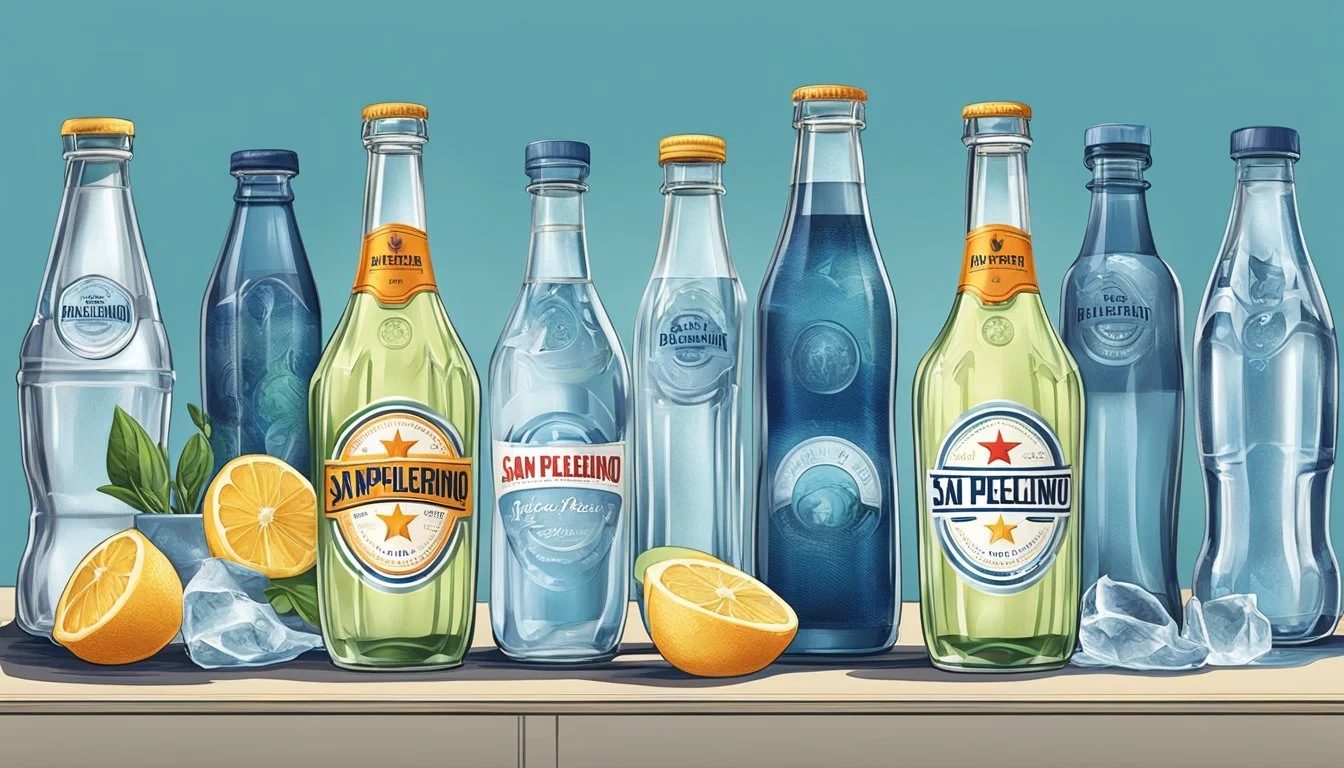San Pellegrino vs. Liquid Death
Which Bottled Water is Better for You?
When choosing between San Pellegrino and Liquid Death, consumers often find themselves comparing two distinct brands with unique identities. San Pellegrino, known for its rich heritage and sophisticated image, offers sparkling natural mineral water celebrated for its taste and the quality of its source. On the other hand, Liquid Death stands out with its bold, edgy branding, canned packaging, and a modern approach to marketing mineral water.
San Pellegrino’s sparkling water provides a slightly acidic pH of 5.6, despite claims of a more alkaline nature at the source in Italy. It appeals to those who prefer a traditional taste and luxurious feel. Contrastingly, Liquid Death aims to "murder your thirst" with its effervescent, refreshing profile, attracting a younger demographic who appreciate its fun and irreverent branding.
For those weighing cost and aesthetic appeal, Liquid Death tends to be on the pricier side due to its unique marketing and packaging. San Pellegrino offers a touch of classic luxury at a competitive price. These differences make the choice between the two a matter of personal preference and lifestyle.
Origin and History
San Pellegrino and Liquid Death have unique origins and histories that contribute to their distinct identities in the bottled water market. From traditional Italian heritage to a modern brand emergence, these waters offer more than just hydration.
San Pellegrino: Italian Heritage
San Pellegrino hails from the town of the same name in the Italian Alps. Since its founding in 1899, this sparkling mineral water has become renowned for its crisp taste and effervescence. The water is sourced from natural springs formed by centuries of volcanic activity.
San Pellegrino's journey to international acclaim began in Italy, where it quickly became a household name. Its signature green bottle and the brand's association with fine dining have further cemented its status as a premium choice.
Liquid Death: Brand Emergence
Liquid Death emerged as a modern disruptor in the bottled water industry. Founded in 2019, this brand took a unique approach by packaging its mountain water in aluminum cans. This move was both an environmental statement and a marketing strategy to stand out in a saturated market.
The water comes from the Austrian Alps and is known for its purity. Liquid Death's branding, featuring edgy designs and slogans, appeals to a younger, more rebellious demographic. Its rapid rise in popularity showcases the brand's effective blend of quality and distinctive marketing.
Types of Bottled Waters
The world of bottled waters is diverse, offering a range of products with different characteristics. Understanding the differences between these types helps consumers make informed choices based on taste, health benefits, and intended use.
Understanding Sparkling Water
Sparkling water, also known as carbonated water, is a popular choice for those who enjoy fizzy beverages without added sugars or artificial flavors. This type of water contains dissolved carbon dioxide gas, either naturally occurring or added artificially.
San Pellegrino, for example, is a well-known sparkling mineral water, sourced from natural springs. It is prized for its refreshing taste and fine bubbles. Seltzer and club soda are other types of carbonated water, but they differ from sparkling mineral water in that they often have carbon dioxide added during production and might include additional minerals or salts.
Mineral Water and Its Distinctiveness
Mineral water is naturally sourced from springs and contains a variety of dissolved minerals. These minerals can include calcium, magnesium, and sodium, giving the water specific health benefits and distinct taste profiles.
Natural mineral water is regulated and must meet strict guidelines regarding mineral content. For instance, waters like San Pellegrino and other premium brands are often preferred for their high mineral content and balanced taste. Unlike distilled or purified water, mineral water provides a naturally refreshing taste and can contribute to the hydration and electrolyte needs of the body.
Comparison with Other Carbonated Beverages
When comparing mineral water with other carbonated beverages like tonic water, it’s important to note the key differences. Tonic water contains added sugars and quinine, making it less suitable for those seeking a simple hydration solution. Seltzer and club soda, while similar to sparkling water, might include added sodium or other minerals, which can affect taste and health preferences.
Bottled water brands like Liquid Death, known for their unique marketing and mountain water origin, offer non-carbonated and sometimes carbonated options, catering to a different set of consumer preferences. Their focus on natural spring water juxtaposes the more traditional sparkling and mineral waters, providing a distinct drinking experience.
In essence, the variety in bottled waters allows consumers to select based on their specific needs, ranging from plain hydration to a flavorful, mineral-rich experience.
Product Ingredients and Health
San Pellegrino and Liquid Death differ in their ingredients and health impacts. San Pellegrino boasts a blend of natural minerals, while Liquid Death offers a no-sugar, vegan-friendly option.
Analyzing Water Ingredients
San Pellegrino contains natural mineral water sourced from the Italian Alps. It features minerals such as calcium, magnesium, and sodium, which contribute to its unique taste. The natural carbonation provides a pleasant fizz, created by the addition of carbon dioxide.
Liquid Death offers both flat and sparkling options. The sparkling variant contains just two ingredients: mountain water and carbon dioxide for carbonation. The brand emphasizes purity, with no added sugars, flavors, or calories, making it a straightforward choice for those seeking simple, clean hydration.
Health Benefits and Considerations
San Pellegrino's mineral content, specifically calcium and magnesium, can be beneficial for bone and muscle health. Sodium levels, while lower than many sodas, still require moderation for those monitoring their intake. The water is also free from calories, sugar, gluten, and is vegan.
Liquid Death markets its product as a healthy alternative due to its lack of sugars and additives. The aluminum cans are considered environmentally friendly compared to plastic bottles. With no calories, no sugar, and being gluten-free and vegan, it suits various dietary needs. However, the flavored versions contain added sugars, which could be a concern for individuals managing their sugar intake.
Taste Profile
San Pellegrino and Liquid Death offer distinct taste profiles, influenced by their mineral contents, carbonation levels, and flavor variations. Understanding these aspects can help consumers choose the bottled water that best suits their preferences.
Flavor Variations
San Pellegrino is known for its classic sparkling mineral water, often packaged in glass or PET bottles. It also provides flavored options like lemon and orange, using natural flavors and real squeezed fruit. These flavors enhance the taste without being overly sweet or artificial.
Liquid Death, on the other hand, focuses on its unique branding and offers a standard, crisp sparkling water. Although less known for flavor diversity, the purity of its source contributes to its popularity.
Sensory Experience of Carbonation
The carbonation in San Pellegrino is fine and subtle, creating a gently bubbly mouthfeel. This effervescence does not overpower the natural mineral taste, making it refreshingly balanced.
Liquid Death’s carbonation is more intense, delivering a stronger burst of bubbles. This can be appealing to those who enjoy a more vivid sensory experience during their beverage consumption. In terms of mouthfeel, Liquid Death offers a robust texture that pairs well with its distinctive branding.
The Role of Natural Flavors
San Pellegrino’s use of natural flavors and real squeezed fruit is a key differentiator. The flavored seltzer options provide a mild sweetness and authentic fruit taste, avoiding artificial aftertastes.
In contrast, Liquid Death prioritizes a clean, straightforward water experience without added flavors. While it lacks the variety in flavor options, its commitment to pure, crisp water appeals to those seeking simplicity.
Both brands cater to different taste preferences, from the subtly fruity and bubbly experience of San Pellegrino to the intense carbonation and clean finish of Liquid Death.
Environmental Impact and Sustainability
Both San Pellegrino and Liquid Death prioritize sustainability, yet their approaches to eco-friendly packaging and industry practices differ.
Eco-Friendly Packaging Choices
San Pellegrino offers its sparkling waters in both glass and plastic bottles. The plastic bottles are made from PET, a widely recyclable material denoted by the recycling symbol with the number "1." Glass bottles used by San Pellegrino are also recyclable, further contributing to their environmental efforts.
Liquid Death stands out with its use of aluminum cans, a material known for its high recyclability. Aluminum can be recycled indefinitely, making it a highly sustainable choice. The brand’s commitment to using recyclable materials highlights a significant focus on reducing plastic waste.
Sustainability in the Water Industry
San Pellegrino emphasizes sustainable production practices. The company supports environmental stewardship, aligning with broader industry standards to limit contaminants and ensure safe, clean drinking water. Their efforts include sustainable sourcing and minimal environmental disruption during the bottling process.
Liquid Death adopts a unique approach by partnering with non-profits to combat plastic pollution. By using aluminum cans and collaborating with environmental organizations, they contribute actively to sustainability. This partnership-driven model showcases the brand's commitment to reducing environmental impact.
Both brands demonstrate their dedication to sustainability through eco-friendly packaging and responsible industry practices. Their environmentally friendly choices cater to increasingly eco-conscious consumers, reflecting broader trends in the bottled water industry.
Brand Positioning and Marketing
San Pellegrino and Liquid Death present distinct brand identities and marketing strategies that carve unique niches in the crowded beverage market. While San Pellegrino taps into heritage and sophistication, Liquid Death embraces a rebellious and modern approach.
Analyzing Brand Identity
San Pellegrino is synonymous with Italian elegance and tradition. Established in 1899 in San Pellegrino Terme, Italy, it promotes its sparkling water as a premium product associated with fine dining and luxury. This brand appeals to consumers who value heritage and a refined lifestyle.
Liquid Death, on the other hand, leverages edgy branding. Launched in 2018, it portrays itself with phrases like “murder your thirst” and advocates for “death to plastic.” Its rebellious persona targets younger, eco-conscious consumers drawn to bold and unapologetic brands. Unlike traditional sparkling water brands such as Perrier and Topo Chico, Liquid Death disrupts the market with its unconventional image.
Advertising and Consumer Engagement
San Pellegrino's advertising emphasizes elegance and lifestyle. Often showcased in high-end restaurants and luxury events, its marketing highlights the aesthetic appeal of its bottles and rich Italian heritage. Collaborations with chefs and events like the San Pellegrino Young Chef competition reinforce its prestige and aspiration.
Liquid Death utilizes viral marketing and humor. Its campaigns are driven by aggressive and engaging social media content, often incorporating user-generated content. The brand's “Keep the Underworld Beautiful” environmental initiative taps into the growing sustainability trend. These strategies differentiate it from traditional competitors like Canada Dry or Mountain Valley.
Liquid Death's unique canned packaging and irreverent tone resonate well with younger audiences, making it a standout in a market dominated by more conventional brands such as La Croix, Spindrift, and Bubly.
Innovation and Trends in Bottling
The bottled water market has seen significant innovations, driven by a demand for sustainable packaging and new flavor experiences. Both San Pellegrino and Liquid Death have positioned themselves at the forefront of these trends.
Redefining Sparkling Water
San Pellegrino has long been a staple in the sparkling water market, known for its natural effervescence and light, crisp texture. Its focus on high-quality, naturally sourced ingredients has made it popular among consumers looking for a refreshing and neutral-tasting beverage. The brand's innovative yet classic approach involves using glass bottles, emphasizing a luxurious feel and improved beverage quality.
Liquid Death, meanwhile, has taken a bold approach by packaging still and sparkling water in aluminum cans. This method not only addresses environmental concerns but also adds a unique, edgy appeal to its products. This brand also stands out by projecting an image reminiscent of craft beer, creating a noticeable buzz in the market.
Emerging Trends and Future Outlook
The future of bottled water lies in sustainability and varied product offerings. Flavored waters, zero-calorie options, and beverages enhanced with natural flavors are increasingly in demand. Both brands are exploring these avenues: San Pellegrino offers a range of naturally flavored sparkling waters, while Liquid Death emphasizes convenience with its easily recyclable cans.
Another emerging trend is the incorporation of health-benefitting ingredients such as potassium and hemp extracts, which aim to appeal to health-conscious consumers. Brands are continually innovating to deliver not just hydration but also additional health benefits, meeting the evolving needs of their audiences.
By embracing these trends, San Pellegrino and Liquid Death are setting new standards in the bottled water industry, balancing tradition with modern demands for convenience and sustainability.
Consumer Guides
Choosing between San Pellegrino and Liquid Death involves considering key factors such as water source, carbonation level, and branding. Additionally, knowing how to serve and pair these sparkling waters can enhance your drinking experience.
How to Choose the Right Sparkling Water
When deciding between San Pellegrino and Liquid Death, the water source is a significant factor. San Pellegrino hails from natural springs in Italy, known for their mineral-rich content. In contrast, Liquid Death boasts mountain water sourced and canned in an edgy, modern style.
Carbonation level also matters. San Pellegrino features gentle bubbles that are less aggressive. Liquid Death offers a more robust effervescence, which some might prefer for a more intense sensation.
Branding is distinct. San Pellegrino presents a classic, sophisticated image, ideal for formal settings. Liquid Death opts for a unique, bold branding, often likened to craft beer aesthetics, appealing to a younger, adventurous crowd.
Serving Suggestions and Pairings
San Pellegrino pairs well with gourmet meals due to its subtle effervescence and mineral profile. It complements dishes such as seafood or light pasta, enhancing the flavors without overpowering them.
For Liquid Death, its strong carbonation and fresh taste make it a fantastic choice for casual settings or spicy dishes. It can be an exciting base for cocktails, adding an unexpected twist to traditional recipes.
Proper serving is essential. Serve icy cold to maximize refreshment. For a sommelier-like experience, use a wine glass to appreciate the bubbles and aroma of the sparkling water fully.
Each brand offers unique experiences. San Pellegrino fits elegant dining, while Liquid Death caters to contemporary, dynamic lifestyles.
More About San Pellegrino
Acqua Panna vs San Pellegrino: Which Bottled Water is Better?
Boxed Water vs San Pellegrino: Which Bottled Water is Better?
Core Hydration vs San Pellegrino: Which Bottled Water is Better?
Ice Mountain vs San Pellegrino: Which Bottled Water is Better?
Icelandic Glacial vs San Pellegrino: Which Bottled Water is Better?
Just Water vs San Pellegrino: Which Bottled Water is Better?
Mountain Valley Spring Water vs San Pellegrino: Which Bottled Water is Better?
Nestle Pure Life vs San Pellegrino: Which Bottled Water is Better?
Poland Spring vs San Pellegrino: Which Bottled Water is Better?
San Pellegrino vs Alkaline88: Which Bottled Water is Better?
San Pellegrino vs Aqua Carpatica: Which Bottled Water is Better?
San Pellegrino vs Cascade Mountain: Which Bottled Water is Better?
San Pellegrino vs Castle Rock: Which Bottled Water is Better?
San Pellegrino vs CBD Living: Which Bottled Water is Better?
San Pellegrino vs Crystal Geyser: Which Bottled Water is Better?
San Pellegrino vs Crystal Lake: Which Bottled Water is Better?
San Pellegrino vs Essence pH10: Which Bottled Water is Better?
San Pellegrino vs Hawaii Volcanic: Which Bottled Water is Better?
San Pellegrino vs Hawaiian Springs: Which Bottled Water is Better?
San Pellegrino vs Kirkland Signature: Which Bottled Water is Better?
San Pellegrino vs Open Water: Which Bottled Water is Better?
San Pellegrino vs Proud Source: Which Bottled Water is Better?
San Pellegrino vs Purely Sedona: Which Bottled Water is Better?
San Pellegrino vs Richard's Rainwater: Which Bottled Water is Better?
San Pellegrino vs Simple Truth: Which Bottled Water is Better?
San Pellegrino vs Smartwater: Which Bottled Water is Better?
San Pellegrino vs Solan de Cabras: Which Bottled Water is Better?
San Pellegrino vs Talking Rain AQA: Which Bottled Water is Better?
San Pellegrino vs Topo Chico: Which Bottled Water is Better?
San Pellegrino vs Weird Water: Which Bottled Water is Better?
San Pellegrino vs Whole Foods 365: Which Bottled Water is Better?
San Pellegrino vs Whole Foods Italian Still Mineral water: Which Bottled Water is Better?
San Pellegrino vs Zephyrhills: Which Bottled Water is Better?
More About Liquid Death
Aqua Carpatica vs Liquid Death: Which Bottled Water is Better?
Core Hydration vs Liquid Death: Which Bottled Water is Better?
Hawaii Volcanic vs Liquid Death: Which Bottled Water is Better?
Hawaiian Springs vs Liquid Death: Which Bottled Water is Better?
Ice Mountain vs Liquid Death: Which Bottled Water is Better?
Icelandic Glacial vs Liquid Death: Which Bottled Water is Better?
Liquid Death vs Cascade Mountain: Which Bottled Water is Better?
Liquid Death vs Crystal Geyser: Which Bottled Water is Better?
Liquid Death vs Crystal Lake: Which Bottled Water is Better?
Liquid Death vs Essence pH10: Which Bottled Water is Better?
Liquid Death vs Kirkland Signature: Which Bottled Water is Better?
Liquid Death vs Proud Source: Which Bottled Water is Better?
Liquid Death vs Richard's Rainwater: Which Bottled Water is Better?
Liquid Death vs Simple Truth: Which Bottled Water is Better?
Liquid Death vs Talking Rain AQA: Which Bottled Water is Better?
Liquid Death vs Whole Foods 365: Which Bottled Water is Better?
Liquid Death vs Whole Foods Italian Still Mineral water: Which Bottled Water is Better?
Mountain Valley Spring Water vs Liquid Death: Which Bottled Water is Better?
Nestle Pure Life vs Liquid Death: Which Bottled Water is Better?
Poland Spring vs Liquid Death: Which Bottled Water is Better?
Purely Sedona vs Liquid Death: Which Bottled Water is Better?
Solan de Cabras vs Liquid Death: Which Bottled Water is Better?






